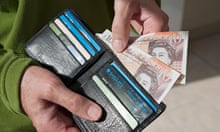The limit on contactless spending in the UK is set to rise to £100, although the change may not be rolled out to shops until later in the year.
The limit on tap-and-go card spending was increased to £45 last year as retailers sought ways to cut the need for physical contact in shops amid the Covid pandemic, and in January plans were announced to more than double it.
The change will be confirmed in Wednesday’s budget.
The chancellor, Rishi Sunak, said the change would provide a boost for shops.
“As we begin to open the UK economy and people return to the high street, the contactless limit increase will make it easier than ever before for people to pay for their shopping, providing a welcome boost to retail that will protect jobs and drive growth,” he said.
While the move will bring contactless card payments up to speed with other methods with no limits, such as Apple Pay, consumer advocates are concerned that millions of shoppers who rely on cash are being left behind.
Also banks and payment providers have warned about the potential for more fraud under the increased limit.
The Treasury said eight out of 10 UK adults had used contactless payments in 2019, before the pandemic hit. In the past year, more retailers have moved away from accepting cash payments, although research has shown that bank notes pose a low risk of spreading the virus.
The higher limit will be legally in force from Wednesday but behind the scenes, systems will need to be changed, so it is likely shoppers will not notice the difference until later this year.
The Treasury said the change was made possible by the UK’s departure from the EU, which meant the country was no longer bound by a £45 limit set by the bloc.
The Treasury added that it was “committed to protecting access to cash”, although no new legislation has been announced.
Angus McFadyen, a partner and payments expert at law firm Pinsent Masons, said the higher limit brought increased risk of fraud and wider card-related crime.
“The industry will need to actively monitor for this and have efficient systems in place for better detection,” he said.
“In the longer term, if fraud levels rise, then we may see an increase in cost of contactless transactions.”
McFadyen said it could also heighten the risk of problem debt at a time when 27.7 million adults were showing signs of financial vulnerability.
“Banks will need to work with their customers to enable them to opt out or limit their own contactless spending levels,” he said.









